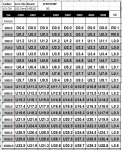I found out about Density Altitude about 6 months ago by a friend. I have a couple of questions. First of all, when you zero say in 30-degree weather, do you simply use the density altitude chart or do you have to re-zero in current weather? Logically, I would think that DA is “generic” and can be used regardless of zeroing weather conditions. Second, I have seen where people say do not use DA in your ballistics programs. Why is that? Isn’t that how I get my DOPE? And, should I only worry about DOPE on every 1k of DA or should I go every 250, 500, 750 as well?
In short, I am very curious about all of this using DA. If not through a ballistics app, is there a better way to calculate DA?
In short, I am very curious about all of this using DA. If not through a ballistics app, is there a better way to calculate DA?


